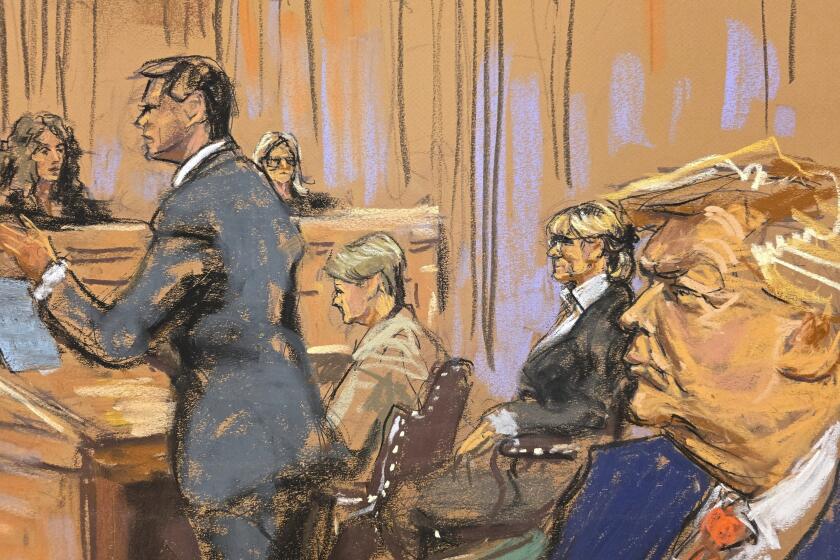Patt Morrison Asks: Diane Keaton
If you’re lazily inclined to define Diane Keaton by the crossword-puzzle-sized word “actor,” you need to get out more. Add to that her work as director and producer, photographer, restorer of venerable houses, board member of the Los Angeles Conservancy and, perhaps above all, as a daughter -- as revealed by her daughter-mother memoir “Then Again.” Little Diane once sat in a neighborhood theater on North Figueroa and watched her mother being crowned Mrs. Highland Park, and wished it were her up on stage instead. In time, she stood on the world stage as a winner of an Academy Award. Her strong connections to her late mother -- like her mother’s dreams of art and beauty -- inform Keaton’s own identity in the here and now.
You find California has more of an aesthetic than people give it credit for.
And it’s varied! You take that drive up [Highway] 1 to San Francisco, you’re on another planet. This state has so much variety, I really want an excuse just to take some more trips where I’m in the car roaming around, just get on the road, drive around California. I’d like to get off the 5 when I head to San Francisco.
You lived in a Quonset hut in Highland Park when you were a child. You’ve loved arches ever since -- your first design aesthetic.
No question about it. Arches add a soft aspect with the drama of the high ceilings. It’s very cozy. On the other hand the Mission style is more severe, and it’s darker, but still very attractive because it’s all wood. Spanish is all stucco. Texturally it’s just fabulous. The Cliff May ranch houses -- Cliff May himself started out in San Diego making little Spanish homes with arches and courtyards and then it evolved into the ranch style, but he always kept that brick that had a lot of texture that made it warm and inviting to me.
The only question I’ll ask about “Annie Hall” is whether you’re tired of people asking about “Annie Hall”?
No, I’m not. Everything is because of “Annie Hall” with Woody. He has a great ear for women’s voices. I’m so grateful to him; he really gave me an opportunity that changed my life. I’m never disappointed about people talking to me about “Annie Hall.” But I will say, a lot of people don’t know “Annie Hall” exists, and that’s just the way it goes -- goodbye! It’s bittersweet.
Your book draws parallels among the generations of women in your family at the same ages.
My mother left that [record] for me. I have letters, journals, her adages, the quotes she wrote down. You put it all together. So the book was just an editing job and my response to her. Here I am, [at, say,] 63. What was [her] 63 and what is my 63? It’s what [acting coach Sandy] Meisner used to say about acting: Live truthfully in the given imaginary circumstance.
Grammy Hall was quite a character; Grammy Keaton was devoutly religious, and I don’t think that helped my mother with her self-esteem. My mother had real dreams of somehow being an artist, but it didn’t quite happen for her because she lived in a very strict religious atmosphere -- no dancing, no lipstick.
Yet she created art and loved design, and kept the journals your book is based on.
It’s a treasure trove, but it also fills me with regret. What’s so great about being an actor is that you have permission to have all these feelings with people because you’re telling a story and it’s not your own; but when it’s your story -- . It was hard for me to kiss her and tell her how much I loved her and appreciated her. This is the regret that I feel about my mother and the fact that I didn’t read those journals before she passed away.
You write a lot about aging. You describe meeting the “fabulous” Audrey Hepburn at the Oscars. She was only 48, and all you could think about was the aging process. Your mother once said, “Don’t grow old, Diane.” And you’ve done those L’Oreal ads: “We’re still worth it.’’
As you get older, it’s hard to remember you are worth it. It was never easy for me to think of myself as “worth it,” so you’ve got to keep working at it. It’s more difficult as you get older, and especially if you’re a public person. The example of Audrey Hepburn -- it’s hard to let go of that, when you’ve been looked at for half your life, [when] people are astonished by your beauty. It’s hard to come to terms with being not as beautiful.
I didn’t allow her to age gracefully; I just remembered her as my fantasy. Then you see your fantasy and, oh my God, she’s a real person. That’ll never do!
You assess beautiful versus pretty too.
Beauty seems to be something that is open to change. And pretty seems to be unimaginative and locked into an idea. Beauty is an experience, not trying to hold onto something that can’t be held onto.
Everybody asks me, now I can ask you -- about your hats.
I discovered them early at the Goodwill because my mother and I were aficionados of all thrift stores. [One] was a kind of bowleresque hat.
And you wanted to wear it to the prom?
I did, but that was the one time my mother said, “Save it for later.” [I like] men’s hats, so you can pull them down over your head so you can hide your face, which is always my intention. I get them too large for my head so the brim lies lower. Nobody’s going to care about this, but these details are very important!
Your style seems so fully thought out -- gloves, jewelry, hat, the proportion of the collar.
I’m armed! Of course it’s fun; there’s an aspect of play to it. Playing with your home, playing with what you surround yourself with -- all that really goes back to my mother teaching me how to look [around]. To me the greatest gift of all is just looking. Why science fiction is [perceived as] more interesting, I never understood. Step outside!
You’ve designed products for Bed, Bath & Beyond.
I did three different beds. I think a bed should not be locked in stone and always the same. Accent pillows, throws are great. I had a piano teacher who told me, “Diane, make work play.” I was about 11 and I thought, “I don’t know what she’s talking about.” But we have to make our beds. That’s a form of work, so why not play with it? I’m going to create new pitchers and accent plates you can use with your regular plates so you’re not just stuck with one color.
You have family talismans like your brother’s artwork, and the rolls of coins your Grammy Hall wrapped and kept. But you also collect decorative objects.
I’m a fan of pictorial Navajo rugs and blankets. I’m a fan of Monterey furniture that reminds me of the missions.
I was in one house you redid and it struck me as decorated very sparely.
No, no, I’m really the worst of the worst. I keep it so it looks like it’s very clean looking, you can only see a few things, but I’m secretly hiding it all over the place. I like to bring out things I’ve stored up and then change it. I do like variety, I like to redecorate. My mother was constantly changing her house.
You curated an exhibit at the Los Angeles Central Library of photos from old L.A. newspapers. What appealed to you about that?
Carolyn Cole [then the photo librarian] came up to me at a swap meet and said, ‘There’s these files in the basement of the Central Library’ -- the most beautiful building. I took a look. There are books and books to be made out of those images. This is a brilliant archive. I’d like to do another one.
L.A. has superb public buildings like the library, and fascinating private houses. You see a Greek Revival house next to a Mission style next to a Mid-century Modern. It’s like a backlot.
It is like a backlot. We have every possible style known to man right here in L.A. We have downtown L.A., it’s beyond beautiful, with our bridges, the Pabst Blue Ribbon brewery. One of my fantasies is somehow, sometime, to live down there.
Yet we tear these great houses down willy nilly.
Look, I’m a preservationist. That’s a hard sell. And it shouldn’t be a hard sell at all. It defines us. It may be that the greatest art L.A. has produced is our buildings. We don’t even have a survey to define what you can and can’t tear down. We’ll work on that.
This interview was edited and excerpted from a longer taped transcript. Interview archive: latimes.com/pattasks.
More to Read
A cure for the common opinion
Get thought-provoking perspectives with our weekly newsletter.
You may occasionally receive promotional content from the Los Angeles Times.











